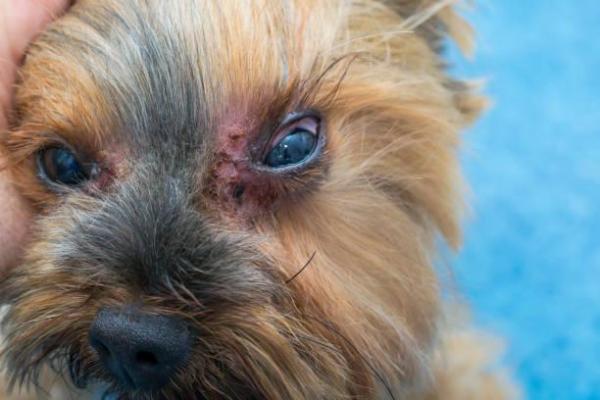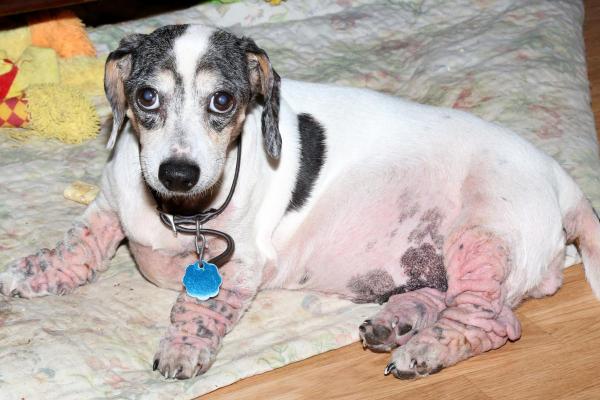My Dog Has Black Spots on His Belly



See files for Dogs
One of the first things we notice about a dog is the color of their fur, but the color of their skin is not always very noticeable. In fact, too many guardians pay insufficient attention to a dog's skin. When a problem develops which leads to symptoms such as flaking, redness, swelling or the presence of black spots, the underlying cause may have had plenty of time to develop. Monitoring the dog's skin is very important. This can be done when brushing, but we should generally check out their skin quality when we get a chance. Dark patches on a dog's skin can be a result of natural skin pigmentation due to melanin, but there are also pathological causes.
AnimalWised explains why my dog has black spots on his belly. We look at both the causes of these back patches on the skin of a dog, as well as what treatment options are available, if treatment is indeed necessary.
1. Benign hyperpigmentation
Thew color of a dog's skin and their hair do not necessarily align directly. The color of a dog is due to the presence of different pigments in their skin, although it is mainly due to two types of melanin known as phaeomelanin and eumelanin. These pigments produce different colors:
- Phaeomelanin: red, cream or yellowish colorations in various tones.
- Eumelanin: mainly black and brown colorations, but can also produce gray tones.
We can see that some dogs have different skin colorations compared to their fur. This disparity is due to different distributions of melanin across the dog's external tissues. Skin coloration is determined by genetic inheritance, but it is possible for skin to change over time.
Benign or normal hyperpigmentation in dogs is the darkening of skin due to a greater production of melanin. It is a progressive darkening of the skin which does not have accompanying signs of inflammation or disease. It is a normal part of the aging process and influenced by factors such as sun exposure and friction. It is for this reason it is most commonly seen in areas such as the armpits and belly.
If you see spots on your dog's belly, it may be due to hyperpigmentation. While their underside might not receive as much sunlight, it is often prone to friction since it comes into contact with the ground more than other areas of the body. It is most visible in hairless dog breeds, but is most common in small breeds such as the Yorkshire Terrier, Chihuahua, Schnauzer, Chinese Crested Dog and Dachshund.
Dark spots on the belly due to hyperpigmentation do not cause itching, odor, hair loss or inflammation. It does not require any specific treatment, although it is important to protect the skin from sunlight.

2. Infections
Hyperpigmentation is not always benign. A darkening of the skin may also be a result of infections. In these cases, there will be the presence of clinical signs since the infection is usually accompanied by inflammation and other related processes. Infections which cause hyperpigmentation and black spots on a dog's belly can include:
- Bacterial: such as those caused by Staphylococcus spp.
- Fungal: such as the yeast Malassezia spp.
- Viral: less common, but can be due to canine papillomavirus (CPV).
While bacteria multiply after injuries, dermatitis or allergies, yeast is a commensal fungus on a dog's skin that becomes pathogenic when a skin imbalance occurs. Viral infections often reduce the efficacy of the animal's immune system, making them more susceptible to secondary bacterial infections. CPV can also result in skin lesions typical of the viral infection.
Bacteria can also be introduced to wounds, something which can affect a dog's belly due to its vulnerability. The dog may run over certain terrain with sharp foliage and result in cuts to the skin. These lesions can be red and inflamed, but they may present as black spots as they heal. We may also see some hair loss, making the skin more visible.
Treatment of skin infections on a dog's belly
Treatment for this type of secondary hyperpigmentation in dogs consists of treating the underlying infection. While bacterial and fungal infections may be treated by antibiotics and antifungal medications, viral infections do not have a curative treatment. In the latter case, it will be necessary to provide supportive treatments and to manage any symptoms.
Some dogs may be more prone to black spots on the belly due to bacterial infections. This could be due to having greater outdoor access or a preexisting health condition. In these cases, we need to be particularly careful and ensure we provide the right levels of hygiene and protection.
Viral infections such as canine papillomavirus can result in other skin conditions, something you can learn about with our article on how to remove warts on dogs.

3. Hypersensitivity or allergy
Allergies or hypersensitivity can also cause black spots on a dog's belly. Hypersensitivity is the term for various types of overactive immune response to various types of antigen. Allergies are specifically due to an allergen, a type of antigen that produces antibodies.
Chronic or acute inflammation can be a result of hypersensitivity responses. Dogs tend to scratch, lick and bite the lesions caused by this inflammation. This stimulates melanin production and thickening of the skin, as well as potential alopecia.
The allergies that most frequently cause black spots on a dog's skin are the following:
- Food allergy
- Atopic dermatitis
- Flea bite allergy
The most affected areas are usually the abdomen, inner thighs, ears, legs, groin and armpits. These symptoms tend to worsen during the peak season of environmental allergies, i.e. spring and summer.
Treatment of allergies in dogs
Treating hyperpigmentation caused by allergies requires controlling the source of the allergy. This can be achieved by the following:
- Food allergy: hypoallergenic or novel protein diet.
- Atopic dermatitis: environmental control in seasonal allergies and use of allergy medications such as antihistamines for dogs such as ebastine.
- Flea bit allergy: comprehensive flea control such as the use of flea collars and other antiparasitic drugs for dogs.
In addition, it may necessary to reduce inflammation with corticosteroids or immunomodulators. These will be prescribed by a veterinarian, so assessment is required if they have chronic hypersensitivity reactions.

4. Cushing's syndrome
Hyperpigmentation can also occur due to hyperadrenocorticism, a common endocrine disease also known as Cushing's syndrome. It is characterized by an increase in glucocorticoid production. This can be endogenous due to a functional pituitary tumor (more than 80% of cases) or an adrenal tumor. Iatrogenic rise in glucocorticoid production is due to the administration of glucocorticoids.
Excess cortisol causes alterations in the metabolism, immune system, muscles and skin. This causes the latter to develop hyperpigmentation or skin darkening, especially in the abdomen, armpits and groin. What may start as black spots on the dog's belly can turn into a thickened appearance reminiscent of elephant skin. Other skin symptoms include skin fragility and symmetrical hair loss on the trunk, neck and flanks.
Cushing's disease in dogs also commonly causes polyuria/polydipsia, increased appetite, swollen abdomen, lethargy, weakness and recurrent urinary tract infections. We look in greater detail at the causes of urinary tract infections in dogs with our related article.
Treatment of Cushing's syndrome in dogs
Treatment for hyperpigmentation caused by Cushing's syndrome or hyperadrenocorticism depends on the source of the glucocorticoid excess and varies from case to case:
- Pituitary hyperadrenocorticism: the treatment of choice is the drug trilostane, which inhibits cortisol production. This is a long-term treatment that requires periodic monitoring.
- Adrenal hyperadrenocorticism: if the tumor is operable, adrenalectomy surgery is performed. Trilostane is administered if not.
- Iatrogenic hyperadrenocorticism: the use of glucocorticoids should be gradually discontinued.
You should know that hyperpigmentation will improve when excess cortisol is controlled, but it may take weeks or months to clear. If there are associated infections, they should be treated with antifungals or antibiotics, depending on the type of infection.
As you can see, there are several reasons why your dog has black spots on his belly. We recommend visiting a veterinarian as soon as they are observed.

This article is purely informative. AnimalWised does not have the authority to prescribe any veterinary treatment or create a diagnosis. We invite you to take your pet to the veterinarian if they are suffering from any condition or pain.
If you want to read similar articles to My Dog Has Black Spots on His Belly, we recommend you visit our Skin problems category.









